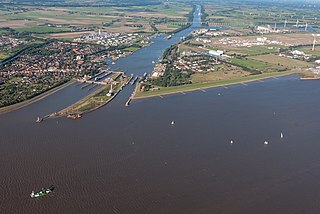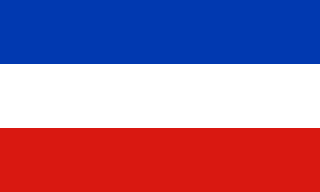
The Kiel Canal is a 98 km (61 mi) long freshwater canal in the German state of Schleswig-Holstein. The canal was finished in 1895, but later widened, and links the North Sea at Brunsbüttel to the Baltic Sea at Kiel-Holtenau. An average of 460 km (290 mi) is saved by using the Kiel Canal instead of going around the Jutland Peninsula. This not only saves time but also avoids storm-prone seas and having to pass through the Danish straits.

Schleswig-Holstein is the northernmost of the 16 states of Germany, comprising most of the historical Duchy of Holstein and the southern part of the former Duchy of Schleswig. Its capital city is Kiel; other notable cities are Lübeck and Flensburg.
Rendsburg-Eckernförde is a district in Schleswig-Holstein, Germany. It is bounded by the city of Kiel, the district of Plön, the city of Neumünster, the districts of Segeberg, Steinburg, Dithmarschen and Schleswig-Flensburg, and the Baltic Sea.

The Schlei, more often referred to in English as the Sly Firth, is a narrow inlet of the Baltic Sea in Schleswig-Holstein in northern Germany. It stretches for approximately 20 miles from the Baltic near Kappeln and Arnis to the city of Schleswig. Along the Schlei are many small bays and swamps. It separates the Angeln peninsula to the north from the Schwansen peninsula to the south.

Swania is a peninsula in Schleswig-Holstein, Germany, protruding into the Baltic Sea. It is located between the Eckernförde Bay to the south and the Schlei inlet to the north.

Anglia is a small peninsula in northern Germany, on the Baltic coast of Jutland. Jutland consists of the mainland of Denmark and the northernmost German state of Schleswig-Holstein. Anglia belongs to the region of Southern Schleswig, which constitutes the northern part of Schleswig-Holstein. The region is often referred to in German as Landschaft Angeln or Halbinsel Angeln.

Eckernförde is a German town in Schleswig-Holstein, Kreis Rendsburg-Eckernförde, on the coast of the Baltic Sea approximately 30 km north-west of Kiel. The population is about 23,000. Eckernförde is a popular tourist destination in northern Germany.

The Bay of Kiel or Kiel Bay is a bay in the southwestern Baltic Sea, off the shores of Schleswig-Holstein in Germany and the islands of Denmark. It is connected with the Bay of Mecklenburg in the east, the Little Belt in the northwest, and the Great Belt in the North.

The Danish Wahld is a peninsula in Schleswig-Holstein, Germany. It is located between Eckernförde Bay in the north and Kiel Fjord in the south. The Amt of "Dänischer Wohld" in the district of Rendsburg-Eckernförde is named after the peninsula, but only encompasses a central part of the region.
Schlei was an Amt in the district of Rendsburg-Eckernförde, in Schleswig-Holstein, Germany. It was situated on the south-eastern bank of the Schlei, an inlet of the Baltic Sea, between Eckernförde and Schleswig. The village Fleckeby was the seat of the Amt.

Schülp bei Rendsburg is a municipality in the district of Rendsburg-Eckernförde, in Schleswig-Holstein, Germany.
Schwansen was an Amt in the district of Rendsburg-Eckernförde, in Schleswig-Holstein, Germany. It covered most of the peninsula Schwansen. The seat of the Amt was in Damp.

The eastern coast of the Jutland Peninsula, consisting of Danish Jutland and German Schleswig-Holstein features a type of narrow bay called Förde in German and fjord in Danish. These bays are of glacial origin, but the glacial mechanics were different from those of Norwegian Fjords and also from those of Swedish and Finnish Fjards. Inlets similar to these are also found on the Door peninsula, Bruce peninsula, and Long island.

Jutland is a peninsula of Northern Europe that forms the continental portion of Denmark and part of northern Germany (Schleswig-Holstein). It stretches from the Grenen spit in the north to the confluence of Elbe and Sude in the southeast. The historic southern border river of Jutland as a cultural-geographical region, which historically also included Southern Schleswig, is the Eider. The peninsula, on the other hand, also comprises areas south of the Eider: Holstein, the former duchy of Lauenburg, and most of Hamburg and Lübeck.

Wagria is the northeastern part of Holstein in the German state of Schleswig-Holstein, corresponding roughly to the districts of Plön and Ostholstein. The word "Wagria" is derived from the Slavic Lechites tribe of Wagri, which meant "those who live by the bays".

The Kiel–Flensburg railway is a single-track railway in Schleswig-Holstein, Germany. The railway connects the city of Kiel on the Baltic Sea with Eckernförde and Flensburg. Travel time over the 80 km (50 mi) railway is around 75 minutes with a maximum speed of 120 km/h (75 mph).

Tourism is an important economic factor for Germany's northernmost state of Schleswig-Holstein.

Eckernförde station is the station of the town of Eckernförde in the German state of Schleswig-Holstein. It is a through station and the most important en-route station on the Kiel–Flensburg railway. It is classified by Deutsche Bahn as a category 5 station. To the north of the entrance building there was also a terminal station of the Eckernförde District Railway until 1958.

The Hütten Hills are an area of upland, up to 105.8 m above sea level (NHN), roughly west of the town of Eckernförde in the county of Rendsburg-Eckernförde in the North German state of Schleswig-Holstein. They lie within the Hütten Hills Nature Park.

The Eider Canal was an artificial waterway in southern Denmark which connected the North Sea with the Baltic Sea by way of the rivers Eider and Levensau. Constructed between 1777 and 1784, the Eider Canal was built to create a path for ships entering and exiting the Baltic that was shorter and less storm-prone than navigating around the Jutland peninsula. In the 1880s the canal was replaced by the enlarged Kiel Canal, which includes some of the Eider Canal's watercourse.





















